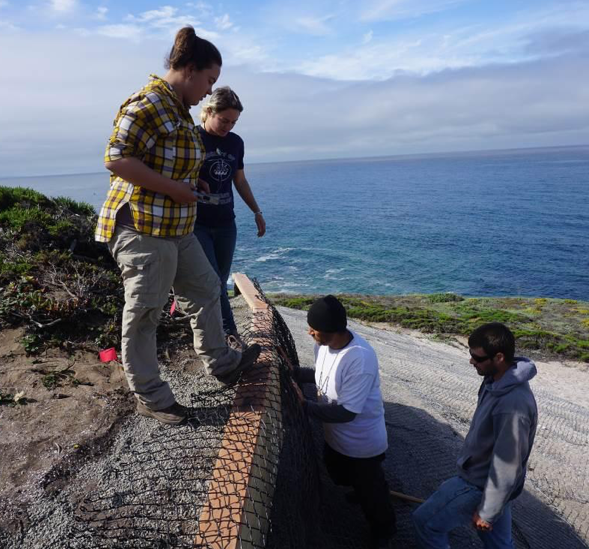RECENT COLLABORATIVE ARCHAEOLOGICAL FIELDWORK ON THE SANTA CRUZ COAST
Text and photos by Kent Lightfoot, AMLT Board Member and UC Berkeley Professor of Anthropology

Processing soil samples using a field flotation system established at Wilder Ranch State Park with (from left to right) Rachel Gordon (UCB undergraduate), Paul Lopez (AMTB), Rosario Torres (UCB undergraduate), and Josh Higuera (AMTB).
A collaborative team of researchers from the Amah Mutsun Tribal Band, California State Parks, UC Berkeley, and UC Santa Cruz initiated archaeological fieldwork on the Santa Cruz coast in the summer of 2016. Our study used our eco-archaeological approach to research different-aged sites across a large area to broaden the study of indigenous landscape management on the Central California coast. While Native people enhanced the productivity of local landscapes in many ways, one of the most important tools in California was fire. They prescribed fires for many reasons: to clear undergrowth, to control insect infestations, to facilitate hunting, and to augment the growth of plants and animals used for foods, raw materials, and medicines. Depending on the frequency, timing, and location of fires, people would have enhanced the biodiversity and sustainability of economic resources and substantially altered the structure of local habitats. By igniting a series of small, low-intensity fires in their tribal territories, Native peoples created patchy mosaics of biotic communities characterized by vegetation stands at different stages of regrowth.

Gabriel Pineida (AMTB) helping to build a retaining wall to protect and preserve archaeological deposits at Sand Hill Bluff with (from left to right) Amanda Dobrov (UCB undergraduate), Michele Maybee (UCB undergraduate), and Rob Cuthrell (UCB archaeologist and AMLT Research Associate).
The current investigation builds upon a methodology developed earlier at Quiroste Valley in Año Nuevo State Park, as outlined by Rob Cuthrell in this newsletter, for examining past indigenous landscape burning using both ecological and archaeological data sources. We are using multiple lines of physical evidence to document when indigenous peoples first initiated sustained practices of prescribed burning on the Santa Cruz coast and how they changed these practices over time. We are particularly interested in examining how Native groups used these practices to transform the composition of local biological communities. The study was funded by the National Science Foundation, the Research Institute for Humanity and Nature, and the Class of 1960 Chair in Undergraduate Education at UC Berkeley. California State Parks provided logistical support throughout the fieldwork, along with the Amah Mutsun Land Trust and Sempervirens Fund.

Roberta Jewett (UCB archaeologist), Rosario Torres (UCB undergraduate) and Abran Lopez (AMTB) recording soil color from a shallow surface survey unit at Sand Hill Bluff.
We investigated four sites (CA-SCR-7,-10,-15,-123/38) along the Santa Cruz Coast south of Año Nuevo Point that contain archaeological deposits that date to the Middle Holocene (6000-3000 BP), Late Holocene (3000-500 BP), and the Historical (after 500 BP) Periods. They are ideally suited for addressing research questions about the changing nature of indigenous resource management practices over time. The first site, CA-SCR-7 (Sand Hill Bluff Site), is an imposing shellmound that contains deeply stratified archaeological deposits dating between 3000 to 7000 BP. The second site, CA-SCR-10, sits on a nearby agricultural field and may date to the Middle Holocene. The third site, CA-SCR-15, consists of a well-preserved Late Holocene village, which was occupied after 1200 BP. The final site we examined was CA-SCR-123/38 in Wilder Ranch State Park. It is comprised of an extensive shellmound dating to Middle and Late Holocene times that underlies a later adobe structure built in the mid-1800s.

Nathan Vasquez (AMTB) screening archaeological materials from excavations at the historical Bolcoff Adobe at CA-SCR-123/38.
We employed a low-impact field program designed specifically to minimize disturbances to the archaeological remains and to avoid human remains and other sacred materials. The field methods include topographic mapping; ground penetrating radar that can reveal buried archaeological deposits; surface collections of archaeological materials; soil collection using augers; and limited excavations. The work was undertaken by California State Park archaeologists and ecologists, UC Berkeley faculty, staff and students, and members of the Amah Mutsun Tribal Band.
Hands-on teaching took place in most of our methods. Five members of the Stewardship Corps of the AMTB participated in all components of the fieldwork during the summer of 2016. They included Josh Higuera, Abran Lopez, Paul Lopez, Gabriel Pineida, and Nathan Vasquez. Eleanor Castro worked as the camp cook and Amah Mutsun Tribal Elder and scholar “in residence” during the field program. She not only provided guidance and insight for the Stewardship Corps members, but also helped train UC Berkeley students and staff about the past and contemporary lifeways, spiritual practices, and cultural values of the Amah Mutsun people. Laboratory research is now underway on the archaeological materials collected this summer, and our findings will be described in a future newsletter article.
In closing, it is important to emphasize that the ultimate goal of our project is to better understand the dynamics of long-term landscape management practices and how the reintroduction of such practices can enhance landscape values today. We are examining how past traditional resource and environment management practices may be integrated with contemporary landscape management to augment the biodiversity and health of biological communities in land preserves and national and state parks in California. We are working closely with California State Parks to explore if indigenous landscape management practices may be reintroduced to increase the availability of native plants and animals employed by tribal members for food, craft production (such as basket making), medicines, and ceremonial regalia.







